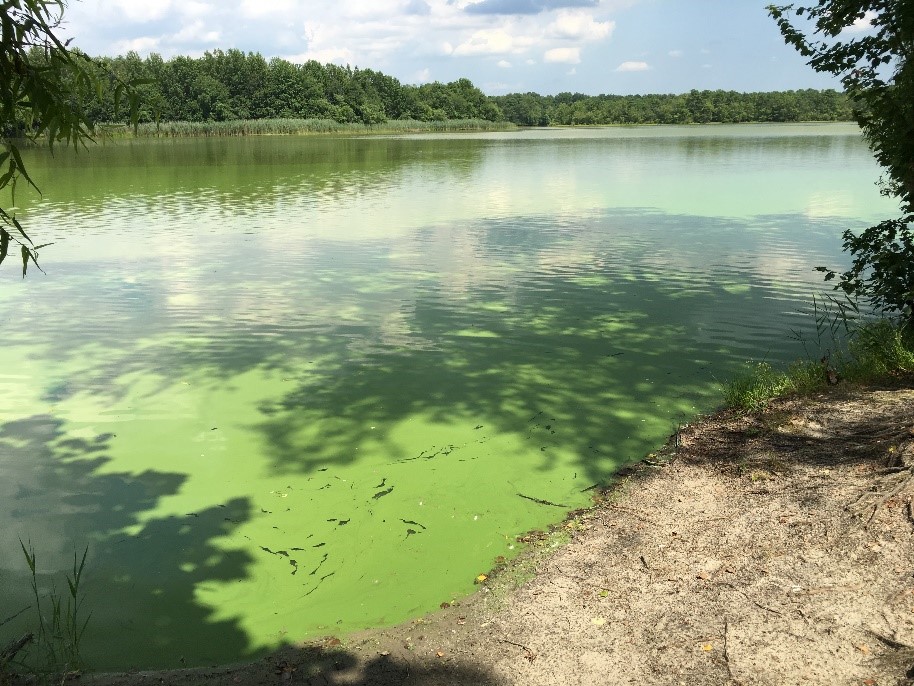(20/P009) TRENTON – The Department of Environmental Protection has awarded $2.5 million in grants for nine local demonstration projects that will implement and evaluate innovative technologies to mitigate and prevent harmful algal blooms in the state, Commissioner Catherine R. McCabe announced today
The grants will fund a variety of projects designed to evaluate the effectiveness of various treatment and prevention technologies, including filtration systems, products to neutralize bloom-causing nutrients, high-tech oxygen bubblers, even floating wetland islands.
 “Identifying new and effective ways to address the growing number of occurrences of harmful algal blooms is a public health and environmental priority for the Murphy Administration,” Commissioner McCabe said. “We are eager to evaluate these technologies and strategies, then share what we learn with communities across the state so that we can better prevent and mitigate these events.”
“Identifying new and effective ways to address the growing number of occurrences of harmful algal blooms is a public health and environmental priority for the Murphy Administration,” Commissioner McCabe said. “We are eager to evaluate these technologies and strategies, then share what we learn with communities across the state so that we can better prevent and mitigate these events.”
This grant program is part of Governor Murphy’s comprehensive $13.5 million plan to mitigate and prevent harmful algal blooms, which affected 39 water bodies last year, including two of the state’s largest lakes – northern New Jersey’s Lake Hopatcong and Greenwood Lake.
While the projects represent short-term actions, it is unlikely that they alone will prevent the recurrence of harmful algal blooms. Long-term prevention will require years of efforts at the state and local levels to reduce the flow of nutrients into waterways, including increased public awareness of reducing the use of fertilizers and proper maintenance of septic systems.
Harmful algal blooms, also known as HABs, are potentially harmful to people and pets. Naturally occurring in lakes and ponds, the algae-like bacteria that causes these blooms can proliferate to unsafe levels under certain conditions, including warm weather, stagnant waters and sunshine.
Many of the funded projects are designed to address excessive levels of nutrients that exacerbate harmful algal blooms. These nutrients come from stormwater runoff containing fertilizers and animal wastes as well as from improperly operating septic systems.
Grants have been awarded for the following projects:
- Lake Hopatcong Commission, $500,000, for a 24-month project including nutrient reduction, direct treatment and habitat modification. The project will include evaluation of filtering media in two stormwater basins, three types of aerators, a product that inactivates the bacteria, treatment with non-copper algaecide, application of a charcoal-like biomass substance known as biochar to remove nutrients from near-shore waters, and the consideration and/or installation of rain gardens.
- Lake Mohawk Country Club/Lake Mohawk Preservation, $160,920, for a 24-month project to demonstrate the effectiveness of non-copper algaecides and phosphorous inactivators, building upon some 30 years of work they’ve done to maintain water quality.
- Mercer County Park Commission, $185,000, for a 26-month project for Rosedale Lake, including installation of an aeration device, use of barley bales to filter stormwater runoff and floating wetlands islands.
- Greenwood Lake Commission, $52,800, for evaluations of ongoing strategies and best management practices to address nutrient input from Belcher Creek, which the commission has identified as a significant contributor to nutrients in the lake. This work will include collection of data for the proper sizing and location of a nutrient treatment system on Belcher Creek and installation of floating wetlands islands to absorb phosphorous.
- City of Newark Department of Water and Sewer Utilities, $475,000, for a 36-month project to prevent harmful algal blooms in reservoirs serving its Pequannock Water Treatment Plant. The city plans to use ultrasonic devices to disrupt the photosynthesis of bacteria. The primary focus of the project will be Echo Lake in Passaic County, with the ability to deploy additional units to other reservoirs.
- New Jersey Water Supply Authority, $115,600, for a 36-month project to protect public health by reducing the intensity and duration of harmful algal blooms at its Spruce Run Reservoir in Hunterdon County through the installation of a biochar system to reduce nutrients entering the reservoir from the Mulhockaway Creek watershed. The project also involves stream and stormwater basin monitoring as part of an effort to determine if biochar can be effective on a more widespread basis.
- Mount Olive Township, $365,000, for a 36-month project to reduce nutrient loadings to Budd Lake through additional mechanical controls of excessive aquatic weeds. The township also will evaluate herbicide treatment of blooms and monitor water quality for early signs for possible herbicide treatment.
- New Jersey Institute of Technology, $500,000, for installation and evaluation of floating mobile platforms in Branch Brook Lake in Essex County and Deal Lake in Monmouth County with micro-nano bubble generators. These machines pump microscopic bubbles into the water column to improve dissolved oxygen. The 36-month project will also include development of a long-term harmful algal bloom strategy for Branch Brook Lake.
- Borough of Hopatcong, $145,680, for a 12-month project to demonstrate the effectiveness of bottom-diffused aeration and prevention of harmful algal blooms at Crescent Cove in Lake Hopatcong. The aeration system will be installed along the entire length of the cove, beginning at the River Styx Bridge.
Project applications were rated on a number of factors. Grants were awarded to those projects deemed ready to be implemented by the upcoming summer season and likely to have successful results. More information about the projects can be found at www.nj.gov/dep/wms/bears/npsrestgrants.html.
Each of the grant recipients is providing a third of total project costs as a match. The match may be made through funding and/or in-kind services. Eligible in-kind services include costs associated with short-term operation and maintenance of the demonstration project.
As part of the broader strategy to better manage blooms, the DEP has issued a draft Intended Use Plan that earmarks $10 million in Clean Water State Revolving Fund money as principal-forgiveness (grant-like) funding for projects that improve water quality, such as centralized wastewater collection to replace septic systems. The DEP is encouraging interested potential applicants, primarily local and county government agencies, to apply for funding available through this program as soon as possible.
In addition, the DEP is currently reviewing applications for $1 million in funding from the nonpoint source pollution grant program for watershed planning to address harmful algal blooms by reducing nutrients in stormwater.
Harmful algal blooms are not caused by true algae. Rather, they are caused by naturally occurring cyanobacteria that can reproduce to unhealthful levels under certain conditions, including sunlight, nutrients from sources such as fertilizers and improperly operating septic systems, warm weather and stagnant water. They frequently form dense mats, resembling pea soup or spilled paint.
Exposure to blooms can result in a range of health effects, including rashes, allergy-like reactions, flu-like symptoms, gastroenteritis, respiratory irritation and eye irritation. Exposure to a bloom that is actively producing cyanotoxins may result in more serious health effects, including liver toxicity and neurological effects. People, pets and wildlife are susceptible to adverse health effects if they come into contact with or ingest water where a bloom is occurring. Consequently, blooms can result in closures of swimming beaches as well as recreational-use advisories.
In 2017, the DEP launched a comprehensive strategy to better monitor and respond to harmful algal blooms. Under this strategy, the DEP is committed to providing assistance to support local governments in efforts to mitigate and prevent these blooms.
For more information on this strategy, the health impacts of these blooms, how to identify them and the science about what causes them, visit www.state.nj.us/dep/hab
DEP PHOTO/Pemberton Lake harmful algal bloom
###
 Official Site of The State of New Jersey
Official Site of The State of New Jersey
 “Identifying new and effective ways to address the growing number of occurrences of harmful algal blooms is a public health and environmental priority for the Murphy Administration,” Commissioner McCabe said. “We are eager to evaluate these technologies and strategies, then share what we learn with communities across the state so that we can better prevent and mitigate these events.”
“Identifying new and effective ways to address the growing number of occurrences of harmful algal blooms is a public health and environmental priority for the Murphy Administration,” Commissioner McCabe said. “We are eager to evaluate these technologies and strategies, then share what we learn with communities across the state so that we can better prevent and mitigate these events.”